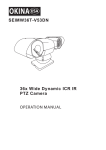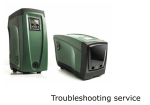Download MiLAN MIL-S8001TG User guide
Transcript
8-Port 10/100/1000 + 1 MiniGBIC Gigabit Ethernet Smart Workgroup Switch MIL-S8001TG User Guide Regulatory Approval - FCC Class A - UL 1950 - CSA C22.2 No. 950 - EN60950 - CE - EN55022 Class A - EN55024 Canadian EMI Notice This Class A digital apparatus meets all the requirements of the Canadian Interference-Causing Equipment Regulations. Cet appareil numerique de la classe A respecte toutes les exigences du Reglement sur le materiel brouilleur du Canada. European Notice Products with the CE Marking comply with both the EMC Directive (89/336/EEC) and the Low Voltage Directive (73/23/EEC) issued by the Commission of the European Community Compliance with these directives imply conformity to the following European Norms: EN55022 (CISPR 22) - Radio Frequency Interference EN61000-X - Electromagnetic Immunity EN60950 (IEC950) - Product Safety Five-Year Limited Warranty MiLAN Technology warrants to the original consumer or purchaser that each of it's products, and all components thereof, will be free from defects in material and/or workmanship for a period of five years from the original factory shipment date. Any warranty hereunder is extended to the original consumer or purchaser and is not assignable. MiLAN Technology makes no express or implied warranties including, but not limited to, any implied warranty of merchantability or fitness for a particular purpose, except as expressly set forth in this warranty. In no event shall MiLAN Technology be liable for incidental or consequential damages, costs, or expenses arising out of or in connection with the performance of the product delivered hereunder. MiLAN Technology will in no case cover damages arising out of the product being used in a negligent fashion or manner. Trademarks The MiLAN logo and MiLAN Technology trademarks are registered trademarks of MiLAN Technology in the United States and/or other countries. To Contact MiLAN Technology For prompt response when calling for service information, have the following information ready: - Product serial number and revision - Date of purchase - Vendor or place of purchase You can reach MiLAN Technology technical support at: E-mail: [email protected] Telephone: +1.408.744.2751 Fax: +1.408.744.2771 MiLAN Technology 1329 Moffett Park Drive Sunnyvale, CA 94089 United States of America Telephone: +1.408.744.2775 Fax: +1.408.744.2793 http://www.milan.com [email protected] © Copyright 2005 MiLAN Technology P/N: 90000xxx Rev. x Table of Contents 1. Introduction Features Software Features Package Contents Ethernet Switching Technology Management Methods 2. Hardware Description Front Panel LED Indicators Rear Panel Desktop Installation Attaching Rubber Feet Power On 3. Network Application Small Workgroup Segment Bridge 4. Console Management Connecting a Terminal or PC to the Console Port 4-1. Main Menu 4-2. VLAN Mode 4-2-1. 802.1Q VLAN Configuration 4-2-1-1. Enabling 802.1Q VLAN 4-2-1-2. VLAN Configuration 4-2-1-3. Create VLAN Group 4-2-1-4. VLAN Status 4-2-2. Port-Based VLAN Configuration 4-2-2-1. Port-Based VLAN Group Configuration 4-3. QoS Control 4-4. Broadcast Storm Suppression 4-5. Restore to Default 4-6. Reset System 5. Troubleshooting 6. Technical Specifications 1. Introduction The MIL-S8001TG switch is a multi-port switch that can be used to build high-performance switched workgroup networks. This switch is a store-and-forward device that offers low latency for high-speed networking. The switch is targeted at workgroup, department or backbone computing environments. Figure 1-1. The MIL-S8001TG switch The 8-Port 10/100/1000 + 1 MiniGBIC Gigabit Ethernet Smart Workgroup Switch features a “store-and-forward“ switching scheme. This allows the switch to auto-learn and store source addresses in a 4K-entry MAC address table. The MIL-S8001TG switch has 8 auto-sensing 10/100/1000 Base-TX RJ-45 ports plus one MINI GBIC slot which enables long-distance connection. 1 Features Conforms to IEEE 802.3 10BASE-T,IEEE 802.3u 100BASE-TX,IEEE 802.3ab 1000BASE-T,IEEE 802.3z gigabit fiber and IEEE 802.3x 8 x 10/100/1000 Base-TX RJ-45 ports 1 MINI GBIC socket for MINI GBIC Fiber transceiver Auto-MDIX on all ports and N-Way Auto-Negotiation 16 Gbps back-plane Quality of service (QoS) supported IEEE802.3x Flow control Back pressure half duplex (10/100Mbps) Flow control full duplex (10/100/1000Mbps) Store-and-Forward switching architecture 1.5Mbits memory buffer Supports 9.5KB JUMBO packet Supports Port-based VLAN and 4K 802.1Q Tag VLAN Supports Broadcast Storm Filtering 4K MAC address table Optional 19” rack mount kit 10” size for desktop and internal power 2 Software Features VLAN QOS Port Based VLAN, support up to 8 groups 4K IEEE802.1Q Tag VLAN 2 Types of quality of service: 1.Port based priority. 2. 802.1p/TOS priority tag System provide 4 queues for High and Low Priority Queue priority. Queue Ratio: High:Middle:Low:Lowest =8:4:2:1 Broadcast Storm filter Disable or Enable Package Contents Unpack the contents of the package and verify them against the checklist below. MIL-S8001TG Switch Power Cord Four Rubber Feet RS-232 cable User Guide Warranty Card If any item is missing or damaged, please contact your local dealer for service. 3 Ethernet Switching Technology Ethernet Switching Technology dramatically boosted the total bandwidth of a network, eliminated congestion problems inherent with CSMA/CD (Carrier Sense multiple access with Collision Detection) protocol, and greatly reduced unnecessary transmissions. This revolutionized networking. First, by allowing two-way, simultaneous transmissions over the same port (Full-duplex), which essentially doubled the bandwidth. Second, by reducing the collision domain to a single switch-port, which eliminated the need for carrier sensing. Third, by using the store-and-forward technology’s approach of inspecting each packet to intercept corrupt or redundant data, switching eliminated unnecessary transmission that slow the network. By employing address learning, which replaced the inefficient receiving port. Auto-negotiation regulates the speed and duplex of each port, based on the capability of both devices. Flow-control allows transmission from a 100Mbps node to a 10Mbps node without loss of data. Auto-negotiation and flow-control may require disablement for some networking operations involves legacy equipment. Disabling the auto-negotiation is accomplished by fixing the speed or duplex of a port. Ethernet Switching Technology supplied higher performance at costs lower than other solutions. Wider bandwidth, no congestion, and the reduction in traffic is why switching is replacing expensive routers and inefficient hubs as the ultimate networking solution. Switching brought a whole new way of thinking to networking. 4 Management Methods The MIL-S8001TG switch series supports Console Management methods Console Management is done through the RS-232 Console Port. Managing the switch in this method requires a direct connection between a PC and the switch. 5 2. Hardware Description Front Panel The Front Panel of the MIL-S8001TG switch consists of eight 10/100/1000Base-TX RJ-45 ports, one MINI GBIC slot, one LED-Indicator for Power, three LED-Indicators (100/1000, LNK/ACT, FDX/COL) for each UTP port, and two LED-Indicators (LNK/ACT) for the Mini-GBIC slot. Figure 2-1. Front panel for MIL-S8001TG RJ-45 Ports (Auto MDI/MDIX): 8x 10/100/1000 N-way auto-sensing for 10Base-T, 100Base-TX or 1000Base-T connections. [In general, MDI means connecting to another Hub or Switch while MDIX means connecting to a workstation or PC. Therefore, Auto MDI/MDIX means that you can connect to another Switch or workstation without changing non-crossover or crossover cabling. ] Mini GBIC slot: The optional MINI GBIC port is shared with port 1 and supports 3.3V. There are 2 LED indicators for the Mini GBIC port – LNK and ACT. 6 7 LED Indicators The LED Indicators give real-time information of systematic operation status. The following table provides descriptions of LED statuses and their meaning. Figure 2-2. LED Indicators LED Power Status Color Description On Green Power On On Green On Orange 100/1000 The port is operating at the speed of 1000Mbps. The port is operating at the speed of 100Mbps. The port is operating at the speed of 10Mbps mode or no device is Off attached. LNK /ACT On Green Blinks Green Off The port is successfully connecting with the device. The port is receiving or transmitting data. No device attached. 8 FDX /COL On Orange Blinks Orange The port is operating in Full-duplex mode. Collision of Packets is occurring in the port. The port is operating in Half-duplex Off LNK (MINI GBIC) ACT (MINI GBIC) On Blinks mode or no device attached. The port is successfully connecting Green with the device. The port is receiving or transmitting Green data. Table 2-1. Description of LED Indicators 9 Rear Panel The 3-pronged power plug and console port are located at the rear panel of the MIL-S8001TG as shown in Figure 2-3. The switch will work with AC in the range 100-240V AC, 50-60Hz. Figure 2-3. The Rear Panel of MIL-S8001TG switch Desktop Installation Set the switch on a sufficiently large flat space with a power outlet nearby. The surface where you put your switch should be clean, smooth, level and sturdy. Provide enough clearance around the switch to allow attachment of cables, power cord and air circulation. Attaching Rubber Feet A. Make sure the mounting surface on the bottom of the switch is grease and dust free. B. Remove adhesive backing from the rubber feet. C. Apply the rubber feet to each corner on the bottom of the Switch. These footpads can prevent the switch from shock/vibration. 10 Power On Connect the power cord to the power socket on the rear panel of the switch. Connect the other end of the cord to an appropriate power outlet. The internal power supply in the switch works with AC in the voltage range of 100-240VAC and frequency 50~60Hz. Check the power indicator on the front panel to see if power is properly supplied. 11 3. Network Application This section provides you a few samples of network topology in witch the Switch is used. In general, the 8 Gigabit Copper with one MINI GBIC Smart switch is designed as a segment switch. That is, with its address table (4000 MAC address) and high performance, it is ideal for interconnecting networking segments. PC, workstations, and servers can communicate each other by directly connecting with 8 Gigabit Copper with one MINI GBIC Smart switch. The switch automatically learns nodes address, which are subsequently used to filter and forward all traffic based on the destination address. By using Uplink port, the Switch can connect with another switch or hub to interconnect other small-switched workgroups to form a larger switched network. Meanwhile, you can also use fiber ports to connect switches. The distance between two switches via fiber cable can be up to 220 or 550 meters (multi-mode fiber) or 60 kilometers (single-mode fiber). Small Workgroup The MIL-S8001TG switch can be used as a standalone switch to which personal computers, servers, and printer servers are directly connected to form a small workgroup. 12 Segment Bridge For enterprise networks where large data broadcasts are constantly processed, this switch is an ideal solution for department users to connect to the corporate backbone. In the illustration below, two Ethernet switches with PCs, print server, and local server attached, are both connect to the switch. All the devices in this network can communicate with each other through the Switch. Connecting servers to the Switch allow other users to access the data on server. In the below illustration, two 8 Gigabit Copper with one MINI GBIC Smart switch are used to interconnect two small workgroups. By using fiber ports to connect switches, the distance between two switches via fiber cable can be up to 2Km or 30Km (SC single-mode fiber connector). 13 4. Console Management Connecting a Terminal or PC to the Console Port Console management involves the administration of the switch via a direct connection to the RS-232 console port. This port is a female DB-9 connector. From the main menu of the console program, the user has access to manage the functions of the switch. Use the supplied RS-232 cable to connect a terminal or PC to the console port. The terminal or PC to be connected must support the terminal emulation program. 14 After the connection between the Switch and PC is finished, turn on the PC and run a terminal emulation program or Hyper Terminal and configure its communication parameters to match the following default characteristics of the console port: Baud Rate: 9600 bps Data Bits: 8 Parity: none Stop Bit: 1 Flow Control: None Figure 4-1. The settings of communication parameters After you have entered the parameter settings, press the Enter Key and the Main Menu of console management appears. 15 4-1. Main Menu There are five items for selection as follows. VLAN Mode: Configure the VLAN function. QOS Control: Configure the QoS function. Broadcast Storm Suppression: Enable or disable Broadcast Storm filtering function. Restore to Default: Set the system to the default value settings. Reset System: Restart the system. 16 4-2. VLAN Mode Select VLAN Mode to access the VLAN configuration menu. The system supports two VLAN modes – 802.1Q and Port-Based VLAN. At the Main Menu command prompt, type “v” or “V” to enter the VLAN Mode configuration interface. Previous Menu: Enter “q” or “Q” and the command prompt to exit the current interface. 17 4-2-1. 802.1Q VLAN Configuration After selecting VLAN mode from the Main Menu, enter the 802.1Q VLAN configuration interface by entering "8" at the command prompt. Previous Menu: Enter “q” or “Q” and the command prompt to exit the current interface. 18 4-2-1-1. Enabling 802.1Q VLAN Prior to configuring 802.1Q VLAN, the 802.1Q VLAN function must be enabled. Enter “e” or “E” at the 802.1Q VLAN menu command prompt to enable the 802.1Q VLAN function. To disable the 802.1Q VLAN function, enter “d” or “D” at the command prompt. Previous Menu: Enter “q” or “Q” and the command prompt to exit the current interface. 19 4-2-1-2. VLAN Configuration The Port VID can be configured for each port. Enter “v” or “V” at the 802.1Q VLAN command prompt to the access the VLAN configuration interface. Enter the port number to be configured. Next, enter the PVID number to be assigned to the selected port. The PVID range is from 1 to 512. Previous Menu: Enter “q” or “Q” and the command prompt to exit the current interface. 20 4-2-1-3. Create VLAN Group Enter “c” or “C” at the command prompt to access the Create VLAN Group configuration interface. VLAN group ID: Enter the VLAN Group ID at the prompt. Add VLAN group member: Enter “m” or “M” at the command prompt to add the port to the VLAN group, use the command “+port number” to add the port or enter “+A” to add all ports. To remove the port from VLAN group, use the command “-port number” or enter “-A” to remove all ports from group. A maximum of 8 ports can be added to a VLAN group. After the port(s) are added the VLAN group, enter command “q” or “Q” to exit the configuration interface. 21 Tag/Untagged Setting: Enter “t” or “T” at the VLAN Configure command prompt to enter Tag/Untagged Setting configuration interface. Use the command “+port number” to set the port as the Tagged status. Use the command “-port number” to set the port to the Untagged status. After configuration, enter command “q” or “Q” to exit the interface. Previous Menu: Enter “q” or “Q” and the command prompt to exit the current interface. 22 4-2-1-4. VLAN Status VLAN Group Information can be viewed by entering “s” or “S” at the 802.1Q VLAN menu command prompt to access the VLAN Status interface. Enter the VLAN group ID to display the VLAN status. Previous Menu: Enter “q” or “Q” and the command prompt to exit the current interface. 23 4-2-2. Port-Based VLAN Configuration At the VLAN mode menu interface, enter “p” or “P” at the command prompt to access the Port-Based VLAN mode configuration interface. Previous Menu: Enter “q” or “Q” and the command prompt to exit the current interface. 24 4-2-2-1. Port-Based VLAN Group Configuration A maximum of 8 VLAN groups can be configured. The default VLAN group is VLAN 1. 1. Enter the group number to configure a VLAN group. For example: enter “1” for VLAN group 1. 2. To add a port to a VLAN group, use the command “+port number” to add the port or enter “+A” to add all ports. To remove a port from a VLAN group, use the command “-port number” or enter “-A” to remove all ports from the group. In VLAN group 1, the default members are port 1 to port 8. A maximum of 8 ports can be added to a VLAN Group. 3. Enter “s” or “S” at the command promt to save the configuration. 4. To view the VLAN group table, enter “l” or “L”. Previous Menu: Enter “q” or “Q” and the command prompt to exit the current interface. 25 4-3. QoS Control Select QoS Control to access the QoS configuration menu. The system supports two methods of QoS control – Port-Based and 802.1P/TOS. From the Main Menu, enter "q" or "Q" to select QoS Control to enable or disable the Qos function and set the high/low queue priority ratio. Port-Based Enable: Enter “p” or “P” at the command prompt to enable Port-Based function. 802.1P/TOS Enable: Enter “e” or “E” at the command prompt to enable 802.1P/TOS function. Note: Port-Based or 802.1P/TOS function must be anabled prior to configuring the Priority ID Map function. QoS Disable: To disable QoS control, enter “d” or “D” at the command prompt. 26 Priority ID Map: To configure the QoS control high/low weight setting, enter “m” or “M” at the command prompt. Next, enter the selection number, for port priority setting. There are four-priority levels – High, Middle, Low, and Lowest priority level. High Priority: Enter "h" or "H" to enable the highest port priority setting. Middle Priority: Enter "m" or "M" to enable the highest port priority setting. Low Priority: Enter "l" or "L" t to enable the highest port priority setting. Lowest Priority: Enter "s" or "S" to enable the highest port priority setting. 27 Priority ID Map Status: To display the current priority level setting for each port, enter “s” or “S” at the command propmt. If the priority level is not configured, the priority IP mapping will be undefined. Restore to Default: Enter “r” or “R” at the command prompt to return the QoS control values back to their defaults. Previous Menu: Enter “q” or “Q” and the command prompt to exit the current interface. 28 4-4. Broadcast Storm Suppression Enable or disable the Broadcast storm function. In the main menu command prompt, enter command ”b” or “B” to enter the Broadcast Storm Suppression configuration interface. In the command prompt sign, enter command “e” or “E” to enable the broadcast storm function. To disable the broadcast storm function, enter command “d” or “D”. Previous Menu: Enter “q” or “Q” and the command prompt to exit the current interface. 29 4-5. Restore to Default Enter “d” or “D” at the main menu command prompt to return the system to the default values. 4-6. Reset System Enter “r” or “R” at the main menu command prompt to restart the system. Note: The current configuration will remain after the system has been restarted. 30 5. Troubleshooting This section is intended to help you solve some common problems encountered while using the MIL-S8001TG switch. Incorrect connections The switch port can auto detect straight or crossover cable when you link switch with other Ethernet device. For the RJ-45 connector should use correct UTP or STP cable, 10/100Mbps port use 2 pairs twisted cable and Gigabit 1000T port use 4 pairs twisted cable. If the RJ-45 connector is not correct pin on right position then the link will fail. For fiber connection, please note that fiber cable mode and fiber module should be match. Faulty or loose cables Look for loose or obviously faulty connections. If they appear to be OK, make sure the connections are snug. If that does not correct the problem, try different cables. Non-standard cables Non-standard and miss-wired cables may cause numerous network collisions and other network problem. This can seriously impair network performance. A category-5 cable tester is a recommended tool for every network installation. 31 Improper Network Topologies It is important to make sure that you have a valid network topology. Common topology faults include excessive cable length and too many repeaters or hubs between end nodes. In addition, you should make sure that your network topology contains no data path loops. Between any two ends nodes, there should be only one active cabling path at any time. Data path loops will cause broadcast storms that will severely impact your network performance. Diagnosing LED Indicators The switch can be easily monitored through panel indicators to assist in identifying problems. If the power indicator does turn on when the power cord is plugged in, you may have a problem with the power outlet or power cord. However, if the switch powers off after running for a while check for loose power connections, power losses or surges at power outlet. If you still cannot resolve the problem, contact your local dealer for assistance. Cabling RJ-45 ports: Use unshielded twisted-pair (UTP) or shield twisted-pair (STP) cable for RJ-45 connections: 100 connections or 100 Category 3, 4 or 5 cable for 10Mbps Category 5 cable for 100Mbps connections. Be sure that the length of any twisted-pair connection does not exceed 100 meters (328 feet). Gigabit ports should use Cat-5 or Cat-5e cable for 1000Mbps connections and the length should not exceed 100 meters. 32 6. Technical Specifications This section provides the specifications of the MIL-S8001TG switch product. IEEE 802.3 10BASE-T Ethernet, IEEE 802.3u 100BASE-TX Fast Ethernet IEEE 802.3ab 1000BASE-T Gigabit Copper Standard IEEE 802.3z Gigabit fiber IEEE802.3x Flow Control and Back-pressure IEEE802.1p Quality of Service IEEE802.1Q Tag VLAN Protocol CSMA/CD Technology Store-and-Forward switching architecture 14,880 pps for 10Mbps Transfer Rate 148,800 pps for 100Mbps 1,488,000 pps for 1000Mbps Per unit: Power LED Indicators Per port: 100/1000 (Orange /Green), Link/Activity (Green), Full duplex/ Collision (Orange) MINI-GBIC: Link, Activity (Green) Connector 8 Gigabit Copper: RJ-45, Auto-MDI/MDI-X for all port 33 MINI GBIC: 3.3V MINI GBIC slot shared with port #1 Back-plane 16Gbps MAC address 4K Mac with Auto Learning Memory 1.5Mbits for packet buffer Dimensions 250mm x 132mm x 37mm (L x W x H) Power Supply Power Consumption Operating Temperature Operating Humidity Storage Temperature EMI & Safety Input: AC 100-240V, 50/60Hz Output: 5V/4A (internal) 22 Watt (maximum) 0ºC to 45ºC (32ºF to 113ºF) 10% to 90% (Non-condensing) -10ºC to 70ºC FCC Class A, CE, CE/ EN60950, UL, cUL 34 Rev A 35














































